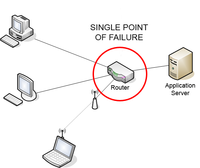- Single point of failure
-
 In this diagram the router is a single point of failure for the communication network between computers
In this diagram the router is a single point of failure for the communication network between computers
A single point of failure (SPOF) is a part of a system that, if it fails, will stop the entire system from working.[1] They are undesirable in any system with a goal of high availability, be it a network, software application or other industrial system.
Systems can be made robust by adding redundancy in all potential SPOFs. Redundancy can be achieved at the internal component level, at the system level (multiple machines), or site level (replication). In computing, this is generally achieved through high-availability clusters.
The assessment of a potential SPOF involves identifying the critical components of a complex system that would provoke a total systems failure in case of malfunction. Highly reliable systems should not rely on any such individual component.
The concept of a single point of failure has also been applied to fields outside of engineering, computers, and networking, such as corporate supply chain management.[2]
Design structures that create single points of failure include bottlenecks and series circuits (in contrast to parallel circuits).
See also
Concepts:
Applications:
In literature:
References
Categories:
Wikimedia Foundation. 2010.
